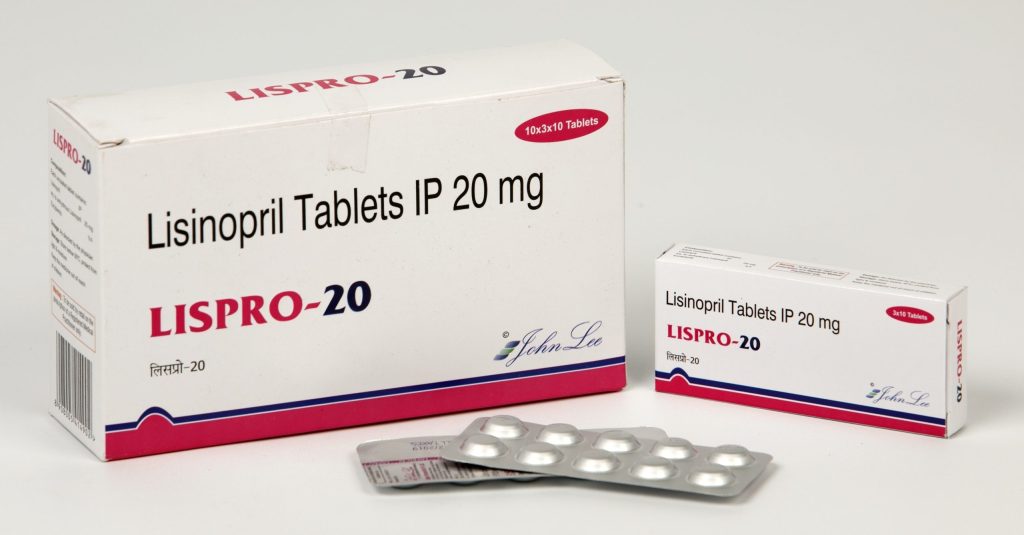In this leaflet you will find understandable information about your medicine – including the effect, use and side effects. Select one of the following chapters to learn more about LISINOPRIL
Chemical Formula

C21H31N3O5
Picture of Lisinopril

How does the ingredient of the medicine work?
The active ingredient indirectly widens the blood vessels. It prevents the release of a substance in the body called angiotensin, which causes the blood vessels to contract and thus increases blood pressure. The blood vessel dilating effect of the active ingredient is also used to relieve the heart, which has to fight against a lower resistance when the blood vessels are dilated. The active ingredient is also known as an ACE inhibitor. The name comes from the fact that the enzyme that ultimately releases the angiotensin is called “angiotensin converting enzyme”.
What is Lisinopril
Lisinopril is classified as an angiotensin-converting enzyme inhibitor and has been available for almost three decades. Lisinopril has some key characteristics that distinguish it from enalapril and captopril; 1) has a long half-life, 2) is hydrophilic, 3) is not cleaved in the liver. Lisinopril is a competitive angiotensin-converting enzyme (ACE) inhibitor and prevents the conversion of angiotensin I to angiotensin II, which is a potent vasoconstrictor. This activity covers lisinopril including mechanism of action, pharmacology, adverse event profiles, relevant patient populations, monitoring and highlights the role of an interprofessional team in the treatment of hypertension with lisinopril.
Lisinopril Therapy
Lisinopril is used in monotherapy and in double or triple combinations, preferably with diuretics or calcium antagonists for the treatment of hypertension, and in monotherapy and double combinations with diuretics for the treatment of symptomatic cardiac insufficiency , with combinations leading to synergistic effects of the substances. Furthermore, an effectiveness in the prophylaxis of reinfarction for up to 6 weeks after a heart attack has been shown. Due to the nephroprotective properties (kidney protection), it can also be used in patients with high blood pressure in type II diabetes mellitus and the onset of kidney diseases (e.g. nephropathy) possible and displayed.
Mechanism of action
As an inhibitor of the angiotensin converting enzyme, lisinopril leads to a reduced formation of angiotensin II from angiotensin I. This reduced formation of angiotensin II causes a decrease in the tone of the blood vessels and thus a decrease in blood pressure. The decrease in the angiotensin II level also leads to a reduction in the release of aldosterone from the adrenal cortex and thus to an influence on the water balance (see also renin-angiotensin-aldosterone system ). At the cellular level, a decrease in mitogenic levels mediated by angiotensin IIEffects on cells of the heart, which lead to unfavorable changes (remodeling) especially after a heart attack, are observed.
Side effects
Most of the side effects of lisinopril are associated with slowed bradykinin breakdown and accumulation caused by ACE inhibitors . These include skin reactions such as B. exanthema and nettle rash , also angioedema . Severe allergic skin reactions, on the other hand, are observed only very rarely.

Respiratory side effects include dry cough, hoarseness, and sore throat. Asthma attacks and shortness of breath can also occur, although rarely.
As a consequence of the main effect of lisinopril, an excessive reduction in blood pressure may occur. As a result, dizziness, headache and light-headedness can occasionally be observed. Severe cardiovascular events such as angina pectoris , myocardial infarction and syncope have only been reported in isolated cases.
Interference with the water and electrolyte balance can occasionally result in functional kidney dysfunction. Proteinuria (excretion of proteins in the urine), on the other hand, was only rarely observed.
Since lisinopril during pregnancy can cause, among other things, growth and bone formation disorders in the child combined with increased mortality, it must not be taken during this time and should be replaced by other suitable therapeutic measures.
Tags: lisinopril side effects, lisinopril brand name, lisinopril online, lisinopril 10 mg, lisinopril dose, lisinopril for sale, long-term side effects of lisinopril, lisinopril 5 mg, lisinopril mechanism of action, lisinopril 20 mg, lisinopril buy

